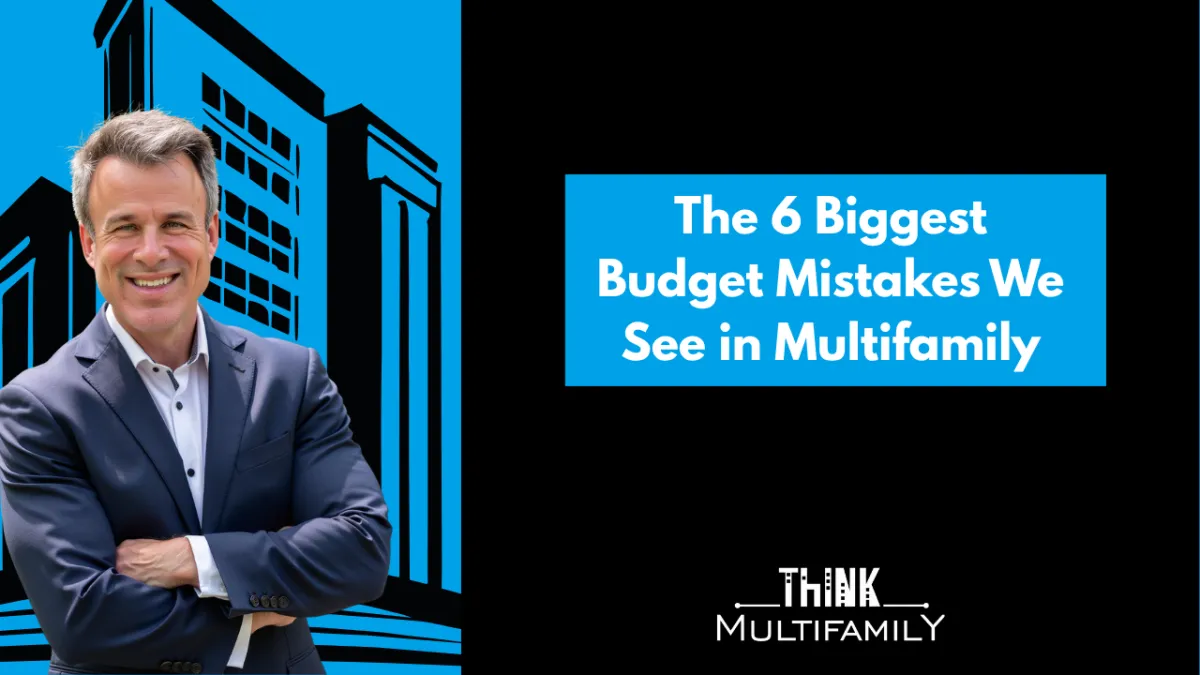
The 6 Biggest Budget Mistakes We See in Multifamily
Think Multifamily | Mark Kenney
Your budget isn’t just a spreadsheet. It’s the heartbeat of your deal. It tells you if the property is viable, whether you’re staying on track, and how much risk you’re carrying.
The problem? If you don’t know how to build and monitor that budget with precision, you’re driving blind.
At Think Multifamily, we’ve reviewed hundreds of pro formas, investor decks, and operating budgets. And we’ve seen good underwriting collapse in real time—thanks to rookie mistakes that could’ve been avoided with a little extra prep.
Here are six of the biggest budget killers we see again and again—and how to sidestep them.
1. Using the Seller’s Numbers Without Scrubbing
📉 The mistake: Plugging the broker’s OM or seller’s T12 straight into your model.
We get it—it’s easy. But those numbers are marketing, not management. Sellers show you the highlight reel, not the messy reality you’ll inherit.
⚠️ Common landmines we’ve spotted:
Utilities underreported thanks to “one-time” fixes.
Payroll missing because the owner self-managed or underpaid family.
Taxes and insurance left at outdated levels that won’t survive closing.
✅ Better move:
Scrub every line in the T12 and rent roll.
Lock in insurance bids before closing.
Confirm tax reassessment risk with your consultant.
Accuracy starts here. If you skip it, the rest of your underwriting is fiction.
2. Forgetting to Reassess Property Taxes
💥 The oversight: Budgeting taxes off the seller’s current bill.
In most markets, property taxes reset after a sale—based on your new purchase price. That $1M bump in valuation? It can turn into a six-figure annual expense.
We’ve watched Year 2 cash flow sink because operators ignored this.
✅ How to avoid it:
Call the county assessor before you close.
Model best, likely, and worst-case scenarios.
Budget to protest taxes proactively.
3. Assuming “Flat” Rent Growth
📊 The lazy shortcut: Adding 3% growth year after year because “that’s the norm.”
Reality check: rent growth isn’t linear. It depends on:
Submarket demand
New supply in the pipeline
Local employment drivers
What tenants can actually afford
Some years you’ll see zero growth. Other years, maybe 6%. If rent growth drives your NOI, it deserves scrutiny—not autopilot.
✅ Smarter approach:
Pull comps from actual leases signed recently, not just CoStar averages.
Line up assumptions with lease trade-out and renewal history.
Match your rent growth to your leasing strategy.
Lazy rent bumps make for pretty pro formas—but painful operations.
4. Underestimating CapEx Timing and Burn Rate
🛠️ The trap: Assuming your $800K CapEx spreads neatly across two years.
In reality, CapEx is front-loaded. Roofs, parking lots, and common areas can eat 60–70% of the budget in the first six months—long before new rents roll in.
That cash flow crunch is what blindsides new operators.
✅ Better practice:
Align CapEx with your renovation timeline and lender draw schedule.
Model working capital month by month.
Over-communicate with contractors to avoid surprises.
CapEx isn’t just about tomorrow’s income—it impacts today’s solvency.
5. Ignoring Staffing Costs
💼 What’s often missed: Underbudgeting on-site staff—or skipping it altogether.
We’ve seen pro formas with $30K for maintenance and nothing for leasing. That might fly for a duplex. It doesn’t for 150 units.
Staffing is the backbone of your resident experience. Underpay your team, and you’ll pay for it later in turnover, bad reviews, and deferred maintenance.
✅ Rules of thumb:
1 leasing agent + 1 maintenance tech per 100 units.
Budget for turnover, training, and temp staff.
Use real salary benchmarks for your market.
Strong teams cost money. Weak teams cost more.
6. No Cushion for Insurance Spikes or Lease-Up Delays
⏳ Post-2020 reality: Insurance is volatile. Premiums can jump 20–40% overnight.
Same with lease-ups. If you assume 90% occupancy in 90 days but hit delays, your pro forma blows up.
✅ Best practices:
Add buffers on key expenses like insurance, taxes, and repairs.
Model a slower lease-up and confirm you have liquidity.
Always include a contingency line item—because surprises aren’t optional.
Final Word
Multifamily budgets aren’t about perfection. They’re about preparation. Scrub the numbers, stress-test assumptions, and build cushions. Do that, and you’ll sleep better at night—and operate with confidence.
👉 Want to Avoid Rookie Mistakes?
Get the Multifamily Fast-Track System—the same blueprint we’ve used in 120+ deals and $1B+ in transactions. All for just $7.
[🔗 Get Instant Access Now]
👉 Want hands-on coaching?
Apply for Group or 1-on-1 Coaching and learn directly from operators who’ve managed through every cycle.
[🔗 Apply for Coaching Today]
Don’t wait until your budget breaks. Start building with confidence now.